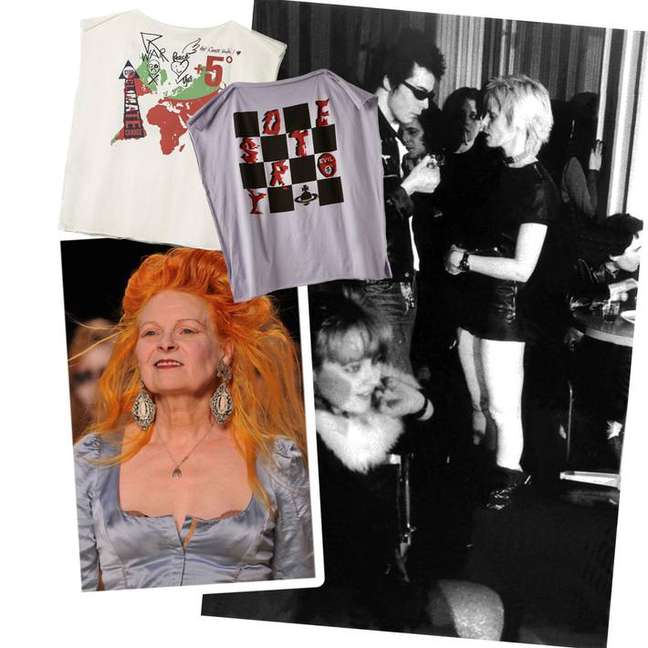Transgressor and forerunner of the counterculture movement, the Englishman leaves an important legacy in fashion
The transgressive spirit, the strong personality and a very personal approach to the act of creating clothes have elevated the English designer Vivienne Westwood (1941-2022) to the position of one of the greatest icons of the fashion market. With her work, Westwood – who died of still unknown causes late last year at her home in Clapham, south London – has transformed British fashion, using her clothes as a channel for relevant messages and taking style of the streets walkway. It all started when Vivienne became one of the world leaders in defining the punk aesthetic.
The counterculture movement was born in the 1970s as a form of protest by young people against social conditions – as usual when speaking of behavioral changes in an era – and had music and fashion as its main expressive bases. With strong roots in nonconformist concepts, punk marked a generation and Vivienne was a key figure in the creation of her look.

The designer achieved the feat with her work in the shop located on London’s famous King’s Road, which she ran with her then husband Malcolm McLaren, manager of the band Sex Pistols. The shop was the symbol and headquarters of his work and for years it underwent transformations and name changes, it opened its doors in 1971 with the moniker “Let It Rock” – mainly focused on vintage clothing and memorabilia – and quickly became a point of reference for the British youth disgruntled with their lives, who would become part of the punk movement.
PROVOCATIONS. Over time, the space began to incorporate other styles of clothing into its product mix, pieces inspired by clothing used in fetishist sexual practices as well as Westwood’s own authorial designs, at the time primarily based on provocation through the pieces, in phrases d impact and in the idea of ’do it yourself’ – here are the pins, tacks, rivets and rips in clothing that are so iconic in punk.
An example of this style is the T-shirt made up of just two squares of fabric sewn together, with openings for the arms and for the head, which has become one of Vivienne Westwood’s fashion symbols, an extremely simple and easily reproducible piece of construction, perfectly in line with the vision of the stylist of the time.
“Like Coco Chanel, Yves Saint Laurent and others, Vivienne Westwood not only followed the spirit of the times, but defined this Zeitgeist. She, along with other names, helped form and consolidate a certain concept and aesthetic standard for fashion , mainly focused on punk,” explains João Braga, professor of fashion history.
Westwood, he points out, was one of the great advocates of the use of black in the market. “She also brought this transgression, which is part of the English behavioral identity. Vivienne had the talent to launch new possibilities within the already established ones”.
It was in 1981 that Westwood and McLaren made their runway debut with the famous Pirates collection. The feat marks a departure from the “classic” punk aesthetic in Vivienne’s career and the entry into a new phase, also characteristic and important in her trajectory. From Piratas, the designer began to bring historical aesthetic references into her fashion, mainly from the 17th and 18th centuries.
Volumes, flounces, classic motifs and even underwear such as corsets have begun to take over their catwalks – all, of course, without leaving aside the transgressive and anarchic spirit and the recognition of street style. “His idea was to unite the past, the present and the possibility of the future. To do this, you need excellent historical knowledge, to update period clothing and make it desirable,” explains João Braga.
«He continued with this attitude until his death. Over the years he began to be more interested in the ethical issues of the market than in the construction of fashion itself. He used his work to denounce and bring the excluded into the social context. he also contributed to giving shape to this moment of inclusion that we are experiencing today”, defines Braga.
“Fashion today has a much more ethical posture than aesthetics, there is no longer a single standard of beauty or a norm of taste. Everything becomes valid”, he warns.
Furthermore, Vivienne was one of the first stylists to talk about “ecological” fashion – a term used in the 80s and 90s to define the relationship between clothes and the environment – she used plush instead of fur in her clothes and was a great promoter of the classic French Toile de Jouy motif – marked by bucolic scenes – as a way of enhancing nature.
His work and its topicality remain completely current with respect to terms today called circular fashion, inclusion and maximum enhancement of the individual personality in dressing. More than a forward-thinking woman, Westwood was a stylist of action and her achievements have gone down in fashion history.
+The best content in your email for free. Choose your favorite Terra newsletter. Click here!
Source: Terra
Camila Luna is a writer at Gossipify, where she covers the latest movies and television series. With a passion for all things entertainment, Camila brings her unique perspective to her writing and offers readers an inside look at the industry. Camila is a graduate from the University of California, Los Angeles (UCLA) with a degree in English and is also a avid movie watcher.






